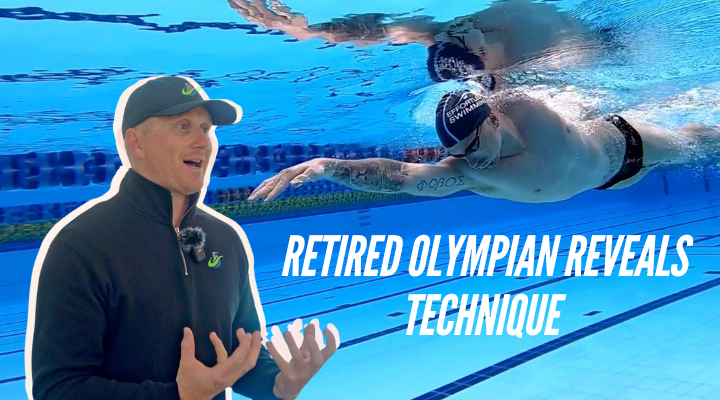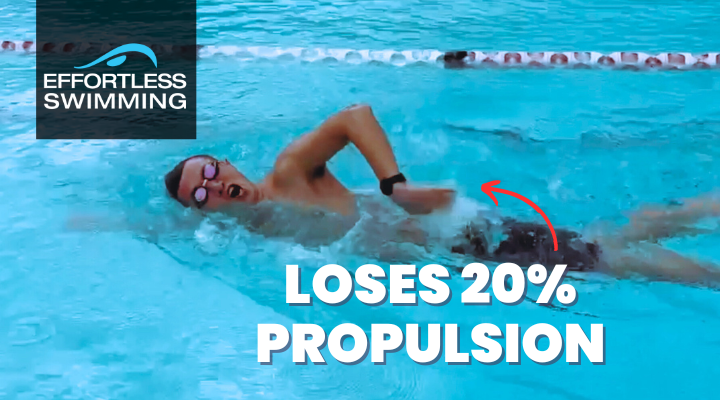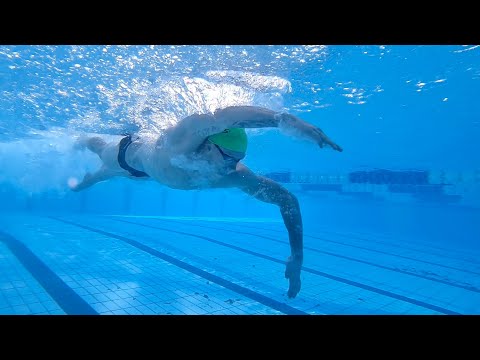Transcription:
So we just want to keep everything quite narrow, quite tight, pretty much keep everything behind the line of the body because that’s what’s going to really make you swim a whole lot faster.
Welcome to Feedback Friday. In this episode, we have a swimmer who … We’ve only got the side footage, but here we’re going to look at … If you’re swimming similar to this, what could you do to increase your speed and make it feel a whole lot easier? And the way that I like to analyze someone’s stroke when I’m sort of thinking about what order do we look at things? It’s following the five core principles, which we’ll put a link to below, they’re on our website, but the first one of those is breathing.
So, if you can breathe deep and you can relax when you breathe, that’s going to make everything else feel a whole lot easier. Now, it looks here with this … There’s a good chance he might run out of breath a bit earlier and a bit sooner than what he should in terms of the fitness, and that can just come down to the way he’s breathing. And one thing that you’ll notice here is that … Because we don’t have the underwater view, we can’t see it as well, but there are quite a few bubbles coming out near his face there, which just indicates that he might be breathing out a little bit too much, too early, because if you exhale everything or you exhale hard in the beginning, then you’re not getting full use of that air that you’ve breathed in.
And so, by the time you go to take your breath, you can feel like, oh, I’m stuffed, I’ve run out of breath already. So what he might need to do here to just make the breathing feel easier, if he does tire a lot quicker, is just changing the way that he’s breathing. So, get the breath, then just, who’s a coach, she calls it adding a calmer, as in get your breath, hold your breath for a split second, then you just have this light exhale while your face is in the water and it’s then, when you’re turning your head to the side, through there, that’s when you have that bigger exhale happen. So that’d be the first thing that I would get him to try.
A great way to practice that is put a pool buoy between your legs, take the balance out of it, take the kick out of it, and just focus purely on your breathing, because then you don’t need to worry much about your stroke or about your body position, you can focus just on changing the breathing. And it can be a very strange thing to feel, a strange thing to think about when you’re swimming, because if you focus just on your breathing, it can actually feel a little bit harder than normal because it feels weird to think just about how you’re exhaling.
But when he makes that change, I think that will keep the heart rate down and it’ll keep the effort down a lot. So I’d do something like six fifties with the pool buoy between the legs, focus just on changing the way that he exhales, and I’d get him to do that as part of his warmup every time that he swims. So that’s the first thing.
The second thing that we look at is we want to find your balance. So, in terms of the balance in the water, the hips and the legs are dropping down a little bit there, not a huge amount, but enough that we’d definitely want to bring it up because the number one thing you’ve got to do in swimming is minimizing drag. So we see drag being created in a couple of ways, one is with the body position. So with the legs dropping down a bit, he’s going to be copping some drag there. The other thing is, on those breathing strokes, you can see how far apart the legs are splaying out the back.
And that’s probably the biggest cause of drag there because it’s like opening a parachute behind you, it’s just going to pull, it’s going to slow you down. So we just want to keep everything quite narrow, quite tight, pretty much keep everything behind the line of the body because that’s what’s going to really make you swim a whole lot faster if your legs are kicking out that wide.
So what’s causing it? Well, I think it could be a combination of things. It could be that with this left arm here, it could be that he’s just overreaching. So he might be trying to stretch out a bit far and maybe rotate a bit far through here and even through his hips. And that over rotation and overreach can really cause that splay at the back because it’s like a counterbalance, it’s going to help you feel like you’re not going to sort of tip all the way onto your side, and so that’s what the legs kick out that wide for.
So it might be that he needs to just reduce his shoulder and hip rotation there and maybe not feel like he’s reaching out as far. A way I really like to train this position is a really simple drill, a sidekick drill, you’ve probably done it before, where you’ve got one arm in front, this arms by the side, and you just got your face down in the water, preferably wearing a snorkel for this drill. So you’ve got your snorkel on and you’re just kicking in that position.
Now, when he’s kicking in that position, what I’d get him to feel for is feel like he’s swimming down this very narrow corridor or like a cylinder there, and that means keeping the kick narrow and keeping this arm right in line with his shoulder and just kicking down that narrow corridor because that’s a great way to train the balance and the feel for that more streamlined position that we want to have in that part of the stroke. So that can be a really good way to practice it.
He could wear fins for that drill as well if he’s got a wet kick, so we’d want to look at that. The other thing we’d probably want to look at here is the breathing. So, as he turns his head to the side, you’ll see that there’s quite a bit of movement. So we’ve got the head, pretty good position it looks like, then what we want to do is just turn the head directly to the side. Imagine you’ve got this skewer through the spine, through the neck, and then the head turns pretty much straight to the side.
You’ll see here that we get these eyes forward there and a bit of a lift in the head. So what we’re probably seeing if we were looking from above, is spine there and the head’s really coming off in that direction and it’s lifting up a lot. And that’s dropping the legs down a lot and it’s just causing the entire body to move off that center, to move off that alignment. So it’s really kind of causing quite a bit of movement up and down with the body and probably we’re getting a bit of curve through the spine as well.
We want to keep that much, much straighter, and the way he’d have to do it is just look more to the side instead of looking so far in front because it’s really just throwing the balance off there. Again, that sidekick drill can be great for practicing that. Take the snorkel off for it and just practice turning the head directly to the side as you’re doing it. Now, you’ll also see that something that stands out here is that right hand comes well across the center, so he’s coming through, entering just in front of his head and then it’s well across the center there. We want to enter in line with the shoulder and extend directly forward.
So, as he’s moving through that, what he’ll have to aim to do there is enter a lot further forward, so feel like he’s entering, probably, here in order to get the hand entering that far in front and he’s going to have to feel very, very wide in order to stop that arm from coming across. So we want the elbow to be up, fingers to be first, entering in that sort of position. It’s going to feel very different compared to what he’s used to doing, but that’s where he’s going to have to get to just get that alignment and that balance.
You’ll notice on the left hand side too, that left arm comes over, it’s quite low to the water, so he would probably just want to get the shoulder out a bit more, elbow coming over a little bit sort of higher, so we don’t want swing that wide over the top, and you’ll notice that the elbow just lands first there as well. So what you might do to just kind of improve that and practice that would be the kickboard press down drill, that can help you just get all of those things happening in your recovery.
And the things that we want in the recovery, shoulder out enough so that the underarm’s out of the water, elbows should be pointing, mostly, to the sky instead of pointing behind you, as you can see there, and then we want that entry to be fingers first, elbow up, in that sort of position, as you can see. So the other things you want to happen in the recovery … So the Kickboard press down drill exaggerates each of those things, and that can be a great way to just learn it. So we might not go onto that straight away, we’d probably just want to work on those other things first, but that would be the next thing.
Then, after that, we’d probably start to move on to the catch in the pool, after that. We could work on that initially, and that’s going to help, but I think getting these other things right first … Getting the breathing right, getting the balance and the alignment in the water and then looking at the catch in the pool, and then onto some of the more complex parts of the stroke, which include finding your rhythm in the stroke there.
So that’s the approach that I’d probably look to take, and this stuff will take some time, and it just depends on what the swimmer’s training for as well, in terms of what sort of style we’d be looking for. And if he’s doing 50 meter sprint, if that’s his main goal, then his stroke’s probably going to be different than if he’s doing triathlon and open water swimming. But that’s the way that we would go about it.
So click the link below, that’ll take you to the five core principles that I like to analyze the stroke, following those ones, and we’ll also give you a good sense of what it is that you might need to work on in your stroke. If you’re confused about finding extra speed, if you know that you can swim faster but you don’t know where it can come from, have a look at those five core principles. And if you want to get the drills and more, more videos and details on how you can go about making those changes, check out the Effortless Swim Video Membership, which we’ll include a link to below as well.
And we do this analysis with people at our clinics around Australia, we’ve got clinics all around the country. We run camps also in Thailand, Hawaii and in Queensland, Australia, and then we also do online video analysis for a lot of centers around the world where they’ll send their videos every two or three weeks of them swimming, and then we provide the feedback and the drills.
And what I like to say to people is these are the drills that I’d recommend doing as part of your warmup every time that you swim, and if you go through those drills, it ends up being about three to 500 meters of some drill swim work, and they will follow those in their warmup every time they swim, and then they will just go about their main set.
And what we see over the course of several months is, by following those drills, sending videos regularly, then they can refine their stroke really, really nice. And when we first started doing this, I thought, surely people can’t improve much by just online coaching, it’s got to be in-person, right? I don’t know what it is about it, but the thing about having your own … Being able to do this on your own time and just having the time and space to be able to sort of figure it out yourself and think about it without someone looking over you and just having this checkup every two or three weeks, it makes a big difference.
And so I was surprised at how well people can improve through online coaching. And so that’s why it’s a service that we offer now, and that’s just offered through the video membership and you’ll find that stroke analysis section there. So thanks again for watching, and I hope you enjoy this video. If you did enjoy it, please like and subscribe. And if you know somebody who’s looking to improve their swimming, maybe send them this video or other videos that you feel will be helpful for them. So thanks again and I will see you next week.









